The Museum Collections
Introduction
I. History and Art Collection
1. Icons of the 14th – 19th centuries
icons of the 14th – 17th century
2. Jewelry art of the 14th – 20th century
jewelry art of the 14th – 17th century
jewelry art of the 18th – 19th century
the european silver 14th - 19th centuries
3. Small-size sculptures (works of metal, wood, bone)
XI – the beginning of the XX century
Small-size sculptures 11th – 17th century
Small-size sculptures 18th – early 20th century
enamel of Troitza masters 15-8th – early 20th century
5.Embroidery, lace, textiles of the 14th - early 20th century
icon and ornamental embroidery
gold and silver lace
6.Painting of the 18th – 21st centuries
painting of the 18th – 19th centuris
painting of the 20th – 21st centuris
II.Manuscripts and old printed books of the 14th – 17th century
IV.Lithography of the 18th – 19th century
V.Numismatics
VI.Medals of the 18th - early 20th century
VIII.Archeology collection
IX. Russian folk and applied and decorative art of the 17th – 21st c.
1. Artistic wood
folk carved and painted wood
wooden toys
house carving of Sergiev Posad
Khokhloma and Gorodets painting
2. Artistic textiles
embroidery and weaving
printed textiles and lace
Russian shawls
folk costumes
folk garments
printed cotton kerchiefs
|
European silver 14th - 19th centuries (page 1)
|
|
The Museum collection of European silver is not large, yet it gives an idea of the level and quality of several European centers, presenting items that are by no way ordinary. Many items are rare. The group of the unique specimens includes the German chalice of the first three decades of the 14th century which is one of the earliest items in the museums of our country; the Lisbon dish of the late 15th century – the heyday of Portugal culture; English silver of Elizabeth’s time.
The chronological boundaries are rather wide – from the 14th till early 20th century, the stylistic range is from Gothic to Modern art.
The works of German and English craftsmen are most interesting for their quantity and quality. The 18th – 19th century of Portuguese, Dutch, Swedish, Polish, Belgian, French silversmiths are represented by single items.
|

Chalice. Germany. 1330-1340th. |
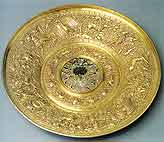
Dish. Portugal. The end of 15th century
|
German silver of the 14th – 19th Centuries |
|
The collection of German jewelry art is most complete. It is only natural, considering the distinguished place occupied by German metal in history of West-European applied art of the 15th – 17th century. Apart from the works of such major centers as Nuremberg, Augsburg, Hamburg, the collection includes single items (or just fragments)made by Lubeck, Dresden, Leipzig, Essen, Munster, Rostock and Breslau craftsman. The earliest work of German silversmiths in the Museum collection is the chalice of the first three decades of the 14th century, donated to the Trinity Monastery by Tsar Ivan the Terrible. This Gothic vessel is a rare and, most probably, unique specimen in our museum collections.
Nuremberg. The collection of Nuremberg silver is represented by the works of the second half of the 16th – first three decades of the 17th century. Stylistically they are Renaissance and Baroque monuments . In Nuremberg it was the time of jewelry art flowering, the time of mass production of precious articles and their wide-spread occurrence in Germany and far outside the country. Of all kinds of objects the collection presents goblets - the most characteristic works of the Nuremberg silversmiths. Since the late 16th century, a silver gilded goblet, of German work as a rule, was the most significant and valuable present for representatives of higher society in Russia. The Museum collection includes goblets made by Nicolaus Schmidt, Caspar and Hans Beutmuller.
|
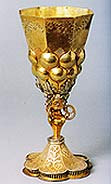
Goblet. Germany. 1612-1626.Craftsman Henry Mack |
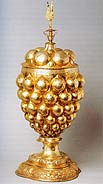
Goblet. Germany. First half 17th century.Craftsman Hans Beutmuller |
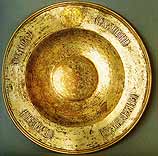
Dish. Germany. 1580-1634.Craftsman Hans Lind
|
|
Àugsburg. Augsburg is another center of German silver work. It is represented by a more diverse group of the 16th – early 18th century articles. Augsburg was formed as a major center of silverwork in the Renaissance epoch in the second half of the 16th century. The Augsburg Renaissance artists created whole albums and series of sheets with ornaments for gold- and silversmiths. The goblet with the Augsburg master’s mark “The crossed hatchets” is an example of their use. The gilded pounced goblet with an egg-shaped bowl can be referred to the late Renaissance Augsburg silver.
The second half of the 17th and the first half of the 18th century became the best periods in Augsburg silverwork. The silversmiths successfully mastered new decorative motifs and ornaments in silver tableware. Few items from the Museum collection demonstrate luxury and variety of baroque ornaments. The baroque dish-basin made by the Augsburg master Hans Jacob I Baur from the Museum collection is brilliantly chased. With impressive size, glittering precious metal and interesting theme “The Triumph of Amphitrite” it looks like a magnificent panel. Both in Europe and in Russia such “basins” were fixed on the walls or exhibited on special stands in the palace halls.
|
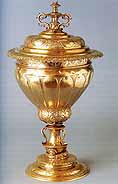
Goblet. Germany. 1570-1575. Master with a stamp «Crossed axes» |
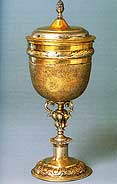
Goblet. Germany. 1620-1625. Master with the monogram "ÍÅ" |
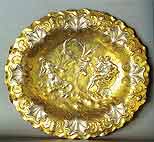
Dish-basin. Germany. 1645-1650. Craftsman Hans Jacob I Baur
|
|
Hamburg and other German towns. The third major center of German artistic silver is represented by several items. There are three Hamburg mugs. The mug is a specific kind of tableware. It appeared in German Renaissance culture. The high cylindrical vessel on a low bottom or without any base, with a necessary lid and handle was widespread in Germany. One of the mugs in the Museum collection is thickly covered with engraved patterns and narrative compositions.
In 16th-17th centuries, German masters skillfully worked not only with silver, but also with the diversified materials, often exotic: a stone, rock crystal, a coco, amber, nacre. Such products had known in Europe since antique times. The example to that is a cup with a bowl from jasper. Vessels from jasper both in Europe and in Russia were appreciated not only beauty of a stone, transparent in a thin layer and various on colour. These subjects supplement an overall picture of gold and silver business of Germany, to no miscellaneous expressing to the tendency of regional art and reflecting various steps of development of styles of the Renaissance and baroque.
German Classical silver is represented by the inkstand made by a Dresden silversmith in the third quarter of the 18th century. The inkstand is shaped like an antique urn on a square bottom. The models for such works were antique archeological finds from Herculaneum and Padua in Italy. The Museum sample of the so-called “stylistic shape”, i. e. made in a certain style, is the rococo tea-pot. Its body with an elongated spout and wavy surface, intricate floral pattern with a shell (“rocaille”) motif reproduce the rococo shapes.
|
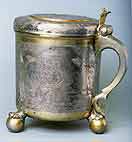
Mug. Germany. The end of 17th century. |
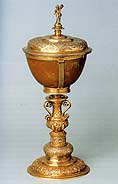
Goblet. Germany. Second half 16th century. Master with the monogram «Íл |
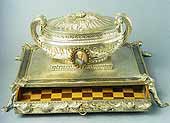
Inkstand. Dresden. Second half 18th century. Unknown master |
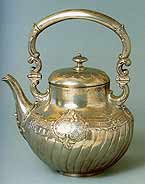
Teapot. Germany. Firm M.H. Wilkens & Sohne. 1886-1896
|
|


